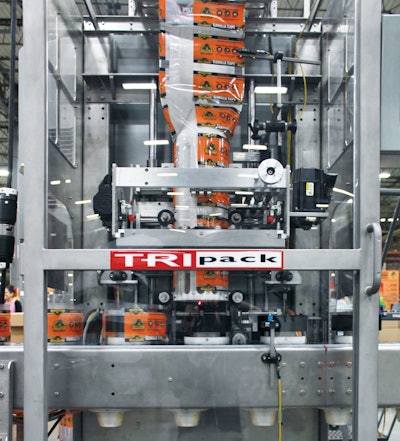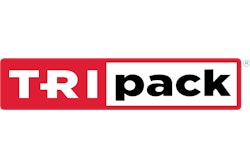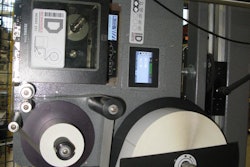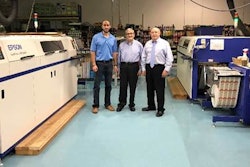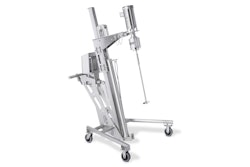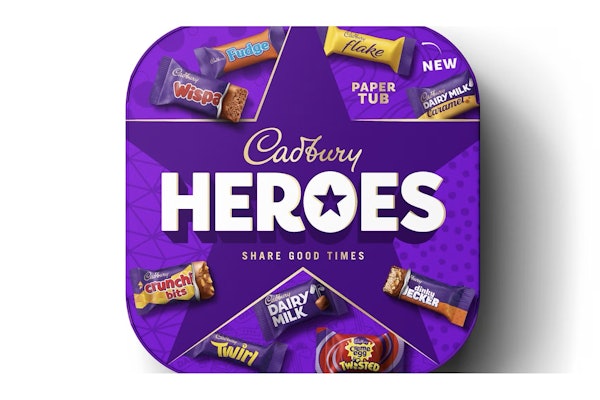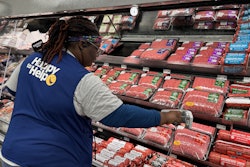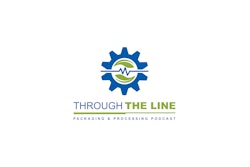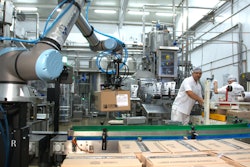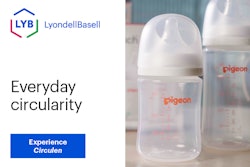For more than 20 years, The Gorilla Glue Company has been selling an original glue product derived from a traditional Indonesian teak furniture adhesive. The Cincinnati company has since expanded its offerings to include Gorilla® Super Glue, Gorilla® Construction Adhesive, and other premium tapes, sealants, and adhesives.
One of the more visible products on hardware and big box store shelves is Gorilla Tape®, recognizable by packaging that features a heavy-browed ape that meets the eyes of would-be DIY weekend warriors and contractors alike. The company uses a host of retail displays and pack formats, but the common denominator is the shrink sleeve.
When Gorilla Glue added the tape line 14 years ago, Tripack, a nearby OEM, demonstrated to the brand just how premium a PET shrink sleeve could make its new rolls of tape look. This three-dimensional label style would let the company take advantage of messaging and branding on each of the surfaces—curved or flat—no matter how the roll was oriented in a display, in a pack, or on a shelf. Plus, according to Tripack, all pertinent information could be applied via one flexible, reliable system. The packaging methodology stuck.
Automation evolution
For the first 14 years, the company considered shrink-sleeve labels to be its preferred method to market and package the tape, and the attitude continues to this day. In fact, it’s now part of the brand identity.
“Since the beginning, we’ve been on a very good growth rate at our company, and tape became one of the core growth items,” says Nik Kostopoulos, Vice President, Engineering and Quality Assurance. “We started off by buying one machine from Tripack at that time, and since then, have bought a second, a third, and, a few months ago, a fourth, just to keep up with the demand. Each machine we’ve bought has represented an improvement in speed, capability, and reliability. The appearance of the product kept improving over the years as well.”
But each machine purchase didn’t come at the expense of a predecessor. The most recent Tripack addition joins the previous three machines—still going strong—to make up the company’s four shrink-sleeve packaging lines. Of course, the first machines were quite manual. Operators hand-placed the rolls of tape into a puck and removed sleeved rolls from each puck by hand. The latest version is much more automatic. Rolls accumulate, then are conveyed, spaced, and automatically installed into a puck system, and are doing so running at a clip of 80 pucks/min, or 80 rolls of tape/min.
“The evolution over time represents a joint effort between what we understand and know, and what Tripack understands and knows,” Kostopoulos says. “We’ve worked closely together to keep making things quicker, better, and easier for us to assemble. We’ve continued to make the older machines more repeatable, and Tripack has been there to help us. They’ve been involved with machine integration, they’ve supported start-ups and new formats, and they’ve helped us keep the machines running, even the older ones with tons of cycles on them.”
All new line automates pucks
To meet messaging demands and avoid sticky exposed tape adhesive, all Gorilla Tape shrink-sleeve label applications require an underwrap. That means the sleever can’t accept flat tapes on a conveyor—each roll needs to be elevated when it gets to the sleever. This is what necessitated a puck system. But on the new, twice-as-fast sleever that the company purchased last year, an all-new material handling system was needed.
A key requirement for the new piece of equipment was the ability to run multiple sizes of tape rolls on the same machine. The new shrink sleever they designed—not completely built to order, but close to it—was able to achieve this by ensuring the puck conveyor system could accept and fit multiple tape sizes without any changeover.
“There’s a sizable number of individual pucks on that conveyor system, and each one would have to be changed out if different tape sizes required different pucks,” Kostopoulos says. “Even a quick changeover would still take quite a bit of time, but not having to change that at all was just a huge benefit for us for flexibility of manufacturing.”
Feeding the puck-studded conveyor is an accumulation table, usually kept back-fed to at least six feet of depth measured in horizontal tape rolls. It collects and feeds each roll into a timing screw, and servos assist in dropping and loading each roll into a receptive puck on the conveyor.
“Previously, this had been a hand-loading operation,” Kostopoulos says. “When you try to time and place a puck by hand, you had better land it. In the case of a distracted operator, for instance, once you miss it, you can’t get it back, and that’s compounded downstream as operators pack rolls into cases and pallets, there’s an opportunity cost all the way down the line. So now, with automated placement of rolls in every puck, plus an accumulation zone that always stays filled, we’re not missing any pucks, ever, throughout the day.”
Given the slower speeds of older machines, this was less of a problem. Two operators, working in harmony or rhythm, could manage and quickly recover from breaks in concentration. But even then, people weren’t perfect. And as potential sleeving speeds grew from 40 or 50/min to 80/min, the upper bounds of manual operation quickly came into sight.
“Just to put an arbitrary manual performance number on that, if a manual operator missed one puck every minute, or one out of every 40 at a 40-per-minute rate, that’s a 2.5 percent throughput reduction,” Kostopoulos says. “By automating it to make it very repeatable and efficient all the way through, and by taking out that human element of coordination between two people, we could pair faster speeds with zero missed pucks.”
Sleever and heat tunnels
Once loaded with rolls of tape, the pucks travel underneath the continuous-motion sleever, where label sleeves are formed into sleeve cylinders, open on the top and bottom, on a mandrel from a single roll of converted 4- to 4.5-micron PET film. The continuous sleeve is metered, then cut to length on the fly.
“The label is kept in place, so it isn’t able to rotate and is pulled through the mandrel forming appropriately,” Kostopoulos says. “There’s some gap or play built in, but it’s shooting running targets constantly at 80 pucks per minute at minimum, and it hits it very consistently.”
Pucks carrying sleeved rolls of tape travel through two shrink tunnels to allow for the proper shrink rate and time. This allows the film to wrap and contour around the roll of tape in such a way that it’s sufficiently repeatable for identical sleeve labels prepared for consumer interaction on the shelf.
“We’ve learned through the process and over the years that once we set the values for how we run our heat tunnels, we don’t ever even touch them, much less modify them,” he says. “This new machine is the same, it just runs robustly all year long with no adjustments. We’ve worked out ways in designing with Tripack to make it basically bulletproof.”
Formats and machine flexibility
Most of the tapes that run on the new line are 1.88 in. wide, or 1.88 in. in height when lying flat on conveyors or pucks. But the machine can run six different sizes, in terms of the amount of tape on the roll, which then determines the width of the roll when lying down.
“We can do so without changeover to the puck system,” Kostopoulos says. “We do have to change over drive screws and mandrels, and we make rail adjustments, but we can do those without tools.”
Tripack developed slides on the back of the conveyor system that allow tape to come off the pucks naturally, and to be presented in a flat state onto conveyors where it is transported to pack cells where operators will hand-pack it into various different displays.
“We pack out into any number of displays for different customers, and it’s all on the fly. Sometimes we pack it out in multiple versions and multiple displays at one time,” Kostopoulos says. “These are mostly corrugated displays, little six packs, 12 packs, 16 packs in displays. Sometimes they’re stacked up like pancakes. Sometimes they’re turned on their sides so they roll down a display as consumers remove them.”
With the most recent capital expenditure of the new shrink sleever in the rearview mirror, Gorilla Tape is in a bit of a holding pattern for new equipment, just watching and waiting. Kostopoulos is still finding ways to improve all four existing sleevers, even the original.
“We’re just monitoring our sales, and we’re trying to stay ahead by about a year before having to make any new equipment decisions,” he says. “We planned to be able to grow into this machine a bit, but sales do continue to grow, so we have to be ready to grow with them.”
Raised image on super-glue blister pack depicts 2-in-1 applicator
In the world of super glue products, there are packages with brushes for glue application, and there are packages with nozzles, but none with both. That is, until Gorilla Glue launched its Super Glue Brush & Nozzle product (shown), with a precision-tip nozzle on top and a fine bristle brush on the bottom of its screw-on closure.
“A consumer doesn’t need just one—that was the motivation for innovating the product,” explains Mary Grace Sillies, Assistant Brand Manager: PR, Social, Creative at The Gorilla Glue Company. “In the lifespan of the glue, they’ll probably need both a brush and a precision nozzle.”
The innovation, she adds, was inspired by combining an astronaut pen with a nail polish brush. “Gorilla aims to stay very approachable,” she says. “Combining familiar tools from other industries was the best way to communicate the functionality to the user.”
But when it came time for Gorilla Glue to design a blister pack for the product, it struggled to find a way to convey the product’s unique two-in-one applicator feature on-shelf. So it was kismet when out of the blue Jeffrey Hayet, President of Sales for think4D Inc., a division of Friesens Corp., sent sales materials to Gorilla’s operations team.
Recalls Hayet, “Within 24 hours, we received a call from them, and they understood what we could bring to the table visually.” What think4D brings is technology that combines flexo printing and thermoforming of PET in-register to create a tactile package.
“We have very high standards, so we needed the package to look perfect, but we didn’t have a ton of room on cost,” says Sillies. “Our design team went back and forth with think4D aiming for the perfect package, and we ended up in a really great place.”
For the Super Glue Brush & Nozzle package, think4D printed an illustration of the two-in-one applicator on top of the blister, with the picture positioned over the opaque super glue bottle, just as the real applicator is positioned inside the bottle. By stretching the plastic in the area where the illustration is printed, think4D created a raised area in the shape of the applicator.
In 2014, as a young, start-up company, think4D created an impressive package for one of Procter & Gamble’s Gillette Venus women’s razor lines (see pwgo.to/3480). The package won a 2015 DuPont Silver Award. Since then, says think4D President Mike Fehr, the technology has matured, and the company has implemented changes to make the process more affordable. “Today, we’re not only a fit for premier packaging,” he says. “We’re also a good fit even for the $6 price-point glue package.”
One change is that rather than having to manufacture parts in order to provide customers with a prototype, think4D now has several lower-cost prototyping options that provide photo-quality renderings. These include digital or production prototypes, printed digitally or HD flexo-printed, respectively, and then formed on a one-up prototype mold using laboratory forming and trimming equipment. Gorilla Glue used the former.
To create the thermoform for the Gorilla Glue package, think4D prints the rollstock PET sheet in three colors using a mid-web flexo press that has “all the latest features,” says Fehr. After the PET material is printed, it is rewound and then thermoformed and trimmed on proprietary equipment built in-house. The depth of draw for the package is slightly greater than one inch.
Key to the process is the ink formulation, which think4D is constantly developing with its ink supplier to get it to stretch in larger areas on the draw of a part. Says Fehr, “For example, we want our ink to be able to stretch in areas like tighter corners and vertical walls where the material is flowing more.” He adds that think4D’s next evolution of inks, expected to be introduced in about a year, will be a quantum leap forward.
According to Hayet, think4D was able to prototype and mass produce the packaging for the new Gorilla Glue product within nine months, allowing the brand owner to meet its launch date commitments to retailers.
Super Glue Brush & Nozzle was launched in 10- and 12-g sizes in both the craft and glue aisles of major retailers, including Walmart, Walgreens, Lowe’s, The Home Depot, and others as well as on Amazon. “Our retailers agreed that it was a much-needed innovation for the consumer,” says Sillies. “There was an unmet need, and we delivered
on it.” —Anne Marie Mohan
